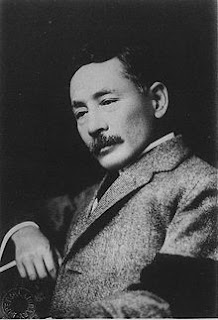Natsumi Sōseki's "Ten Nights' Dreams"
 | ||
| ||
Natsume Soseki's Ten Nights' Dreams, translated by Takumi Kashima and Loretta R. Lorenz, comprises ten dreams written like very short stories. Or are they short stories that appear dreamlike? The strongest of them have the mysterious quality of dreams.
In "The Eighth Night," the narrator-dreamer at a barber shop could see people passing by the lattice-window reflected in the mirror in front of him. When he turned around, however, to see a woman counting her yen, she could not be seen. After he paid and went out of the shop, he saw five oblong basins full of goldfish. The goldfish seller, eyes fixed on the goldfish before him, hardly cared about the busy people passing by.
The dream of "The Tenth Night" was strongly sexual. A young man had to keep tapping the snouts of a never-ending line of pigs. When one pig finally succeeded in licking him, he collapsed.
Other dreams have the rigor of a moral lesson. Challenged by a monk to achieve meditation, the narrator-samurai in "The Second Night" attempts strenuously to meditate, but is defeated by his refusal to be beaten by a monk. "The Third Night" tells the story of a murderer who carries his victim on his back in the shape of a child.
The weaker dream-stories in the collection either do not rise above the anecdotal (like the ninth dream) or end with less surprise than they portend (like the fourth and fifth dreams). My favorite is the tenth and final dream, which reminds me of Legion in the Gospels. The Panama hat, given by the dying young man Shoutarou to his friend Ken-san, who told the story to the narrator, is also a beautiful touch.


Comments